Champagne Lanson
by
Kathy and Terry Sullivan
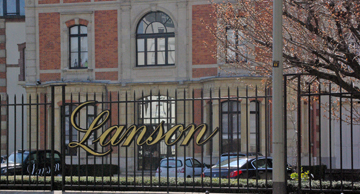 Summary: Champagne Lanson is located in Reims. It is a long but pleasant walk from the Continental Hotel. The Champagne House is one of the oldest champagne houses. Champagne Lanson dates its heritage back to 1760. The names have changed over the years. Today Jean-Paul Gandon is the head winemaker and has been the winemaker at Champagne Lanson for more than 40 years. It is important to recognize that when producing champagnes, Champagne Lanson never uses malolactic fermentation.
Summary: Champagne Lanson is located in Reims. It is a long but pleasant walk from the Continental Hotel. The Champagne House is one of the oldest champagne houses. Champagne Lanson dates its heritage back to 1760. The names have changed over the years. Today Jean-Paul Gandon is the head winemaker and has been the winemaker at Champagne Lanson for more than 40 years. It is important to recognize that when producing champagnes, Champagne Lanson never uses malolactic fermentation.
The Champagne Lanson House has a long history dating back to 1760. It is considered one of the oldest champagne houses. François Delamotte started the champagne house. Later his son Nicolas-Louis Delamotte, a Knight of the Order Malta, continued the leadership of the house, and the Maltese Cross became the logo for Champagne Lanson. In 1837 Jean-Baptiste Lanson, a partner and friend, was asked to manage the champagne house and changed the name to Lanson, Père et Fils. In 1900 Lanson received the Royal Warrant, which means it became the official supplier to the Court of England. Later Jean Baptiste Lanson continued the tradition followed by Victor Lanson. The last Lanson family member involved with the champagne house was in 1976.
Today the winemaker is Jean-Paul Gandon. He has been with Champagne Lanson since 1986. In producing Lanson champagnes he does not use malolactic fermentation. Jean-Paul Gandon’s long term commitment to Champagne Lanson helps the champagne house to continually provide consistency in its champagnes.
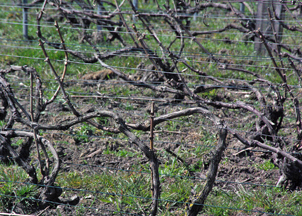 The Tour
The Tour
Our group tour was given by Anaïs Demard who provided detailed information about the history of the champagne house and the champagnes produced at Lanson. The tour began with a map of Champagne and a presentation of the region and the grapes. The grapes are pressed in different regions and the juice is sent to the Lanson facility to be used for the champagnes.
Grapes are harvested in September. While the champagne house usually use the same grape growers, they can purchase grapes from other growers. There is a small vineyard on the property. During our April visit the vines were still asleep. One can observe the running method and architecture of a vine.
After the vineyard stop, our tour took us to the first fermentation building. Multiple stainless steel tanks are lined up side-by-side filling the large area. We then went to another tank room for the reserve wine. Each vat is named for the village from which the juice is produced. Again, multiple stainless steel tanks filled the room. We peered into the barrel room where large wood casks and barriques cast a yellow glow contrasting with the previous two rooms of stainless steel.
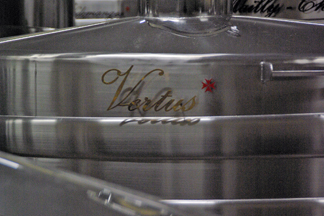
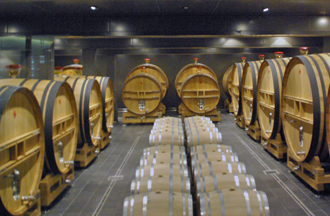
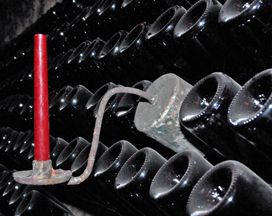 Our tour group then entered the caves under the facility used to cellar champagne. The cellars were built in 1926. The cellars cover seven square kilometers and store 20,000,000 bottles. In addition to bottles stacked horizontally, some bottles were on riddling racks in the process of moving from the horizontal position to a vertical position. Lanson Paradis is a noble cuvée which is hand riddled. Other bottles are riddled with gyropalettes.
Our tour group then entered the caves under the facility used to cellar champagne. The cellars were built in 1926. The cellars cover seven square kilometers and store 20,000,000 bottles. In addition to bottles stacked horizontally, some bottles were on riddling racks in the process of moving from the horizontal position to a vertical position. Lanson Paradis is a noble cuvée which is hand riddled. Other bottles are riddled with gyropalettes.
One cave passage had several pieces of equipment, from a past era, used in the vineyard and champagne house. You can view a cart used to transport grapes, baskets for grapes, pumping equipment, bottle fillers, corking instruments and a disgorgement barrel.
The most widely known non-vintage Black Label wine was produced with Pinot Noir, Chardonnay and Pinot Meunier. The dosage was 10 grams per liter. The champagne had three years of aging which is the minimal for a non-vintage champagne.
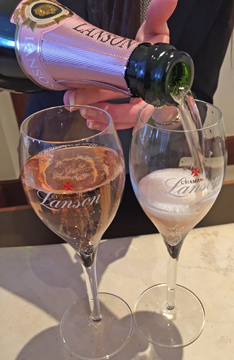 Lanson Champagnes
Lanson Champagnes
We tasted three Lanson champagnes. The Lanson Gold Label Brut Vintage 2005 champagne was a dark yellow to light gold color. This champagne was produced with 50% Pinot Noir and 50% Chardonnay. The base wines had no malolactic fermentation. The champagne was disgorged in March 2014. The champagne had columns of beads forming a mousse on the surface. The wine offered apple and some peach notes. Fresh bread nuances were on the aftertaste.
Lanson Rosé Label Brut Rosé was a salmon color wine produced with Pinot Noir, Chardonnay and Pinot Meunier. A Pinot Noir still wine was used to add color to the blend. The wines used in the rosé did not undergo malolactic fermentation. The champagne was disgorged in February 2014. The dosage measured 10 grams per liter. Columns of beads rose to the surface of the glass forming a circular mousse ring in the center of the glass. The champagne offered raspberry, strawberry and rose petal notes on the aroma and taste.
Lanson Extra Age Blanc de Blancs NV, also with no malolactic fermentation, was disgorged November 20, 2013. The grapes that make up this champagne are from Premier cru and Grand cru vineyards. The yellow champagne had many beads and a large mousse forming on the surface. The champagne had notes of freshly baked bread, pear, apple and some white floral petals.
Wine Tourism
When planning a visit to Reims in Champagne, France be sure to schedule time for a tour at Champagne Lanson. Tours by appointment are available Mondays thru Fridays. You can make an appointment online.
Champagne Lanson
66 rue de Courlancy
51100 Reims
Article written April 2015
Visit these tour operators that partner with Wine Trail Traveler.
 |
||||
France
|
France
|
France | SmoothRed London, England, United Kingdom |


